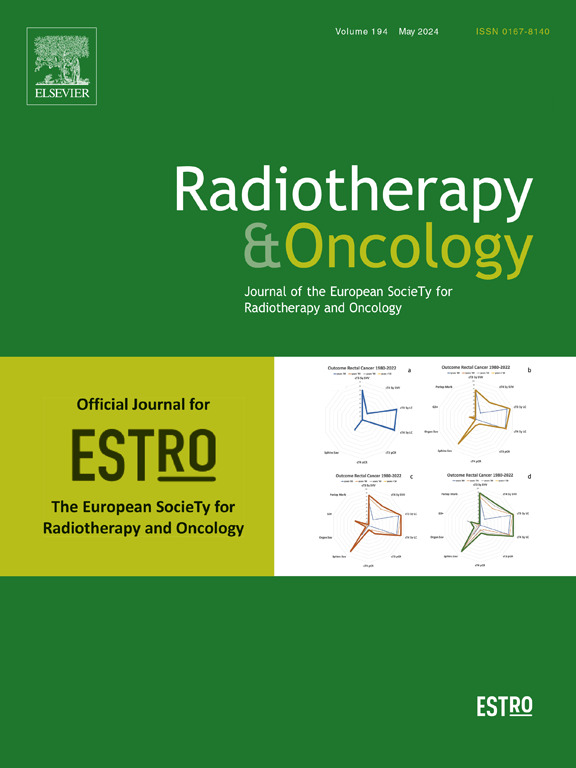确定局部晚期食管癌的最佳放射剂量:随机临床试验中重建个体患者数据的汇总分析。
IF 4.9
1区 医学
Q1 ONCOLOGY
引用次数: 0
摘要
背景:食管癌(EC)的确定同步放化疗(dCCRT)的最佳放射剂量一直是放射肿瘤学关注的问题,并且几十年来一直存在争议,我们基于个体患者数据(IPD)进行了荟萃分析以探索最佳剂量。方法:比较高剂量放疗(HD-RT,≥59.4 Gy)与标准剂量放疗(SD-RT, 50 Gy/50.4 Gy)的随机临床试验(rct)。采用图形重建算法从原始随机对照试验中呈现的Kaplan-Meier曲线中提取时间-事件结果。利用重建的个体患者数据,重新计算HD-RT与SD-RT的总生存期(OS)、无进展生存期(PFS)和局部无进展生存期(LRPFS)。报告的OS、PFS和LRPFS的风险比(hr)也采用固定或随机效应模型进行汇总。结果:纳入6项随机对照试验,共1722例患者。OS、PFS和LRPFS的IPD分别为1287例、462例和722例。总的来说,HD-RT没有显著的好处三年操作系统(RR = 1.00,P = 0.990),3年无进展生存(PFS) (RR = 0.96,P = 0.320)和3年局部区域无进展生存(LRPFS) (RR = 0.88,P = 0.204),相比之下,SD-RT。与上述结果一致,HD-RT与SD-RT的OS、PFS和LRPFS的合并hr分别为0.99 (P = 0.854)、0.94 (P = 0.628)和0.91 (P = 0.410)。然而,HD-RT有更高级别 ≥ 3治疗相关不良反应(TRAEs) (OR = 1.26,P = 0.025)。根据RT技术、组织学、RT靶点大小、剂量递增模式和分期进行亚组分析。我们发现,即使在亚组中,剂量增加也不能使长期生存受益,但会导致 ≥ 3级TRAEs的发生率升高。结论:结果提供了强有力的证据,证实了目前的指南,并支持应用SD-RT的临床实践。此外,它为进一步研究新的药物组合(例如,免疫疗法)而不是辐射剂量增加的可行性提供了启示。本文章由计算机程序翻译,如有差异,请以英文原文为准。
Determining the optimal radiation dose for locally advanced esophageal cancer: A pooled analysis of reconstructed individual patient data from randomized clinical trials
Background
The optimal radiation dose of definitive concurrent chemoradiotherapy (dCCRT) for esophageal cancer (EC) has always been a concern in radiation oncology and has remained controversial for several decades, we performed a meta-analysis based on individual patient data (IPD) to explore the optimal dose.
Methods
Randomized clinical trials (RCTs) comparing high-dose radiotherapy (HD-RT,≥59.4 Gy) with standard-dose radiotherapy (SD-RT, 50 Gy/50.4 Gy) were identified. Graphical reconstructive algorithms were employed to extract time-to-event outcomes from Kaplan-Meier curves presented in the original RCTs. Using reconstructed individual patient data, summary overall survival (OS), progression-free survival (PFS) and locoregional progression-free survival (LRPFS) for HD-RT versus SD-RT were recalculated. Hazard Ratios (HRs) of OS, PFS and LRPFS reported were also pooled by the fixed or random effects model.
Results
Six RCTs, including 1722 patients, were included. IPD for OS, PFS, and LRPFS were from 1287, 462, and 722 patients, respectively. Overall, HD-RT had no significant benefits in 3-year OS (RR = 1.00, P = 0.990), 3-year progression-free survival (PFS) (RR = 0.96, P = 0.320) and 3-year locoregional progression-free survival (LRPFS) (RR = 0.88, P = 0.204), compared with SD-RT. Consistent with above results, the pooled HRs of OS, PFS and LRPFS for HD-RT versus SD-RT were 0.99 (P = 0.854), 0.94 (P = 0.628) and 0.91 (P = 0.410), respectively. However, HD-RT had higher grade ≥ 3 treatment-related adverse effects (TRAEs) (OR = 1.26, P = 0.025). Subgroup analyses were also performed based on the RT techniques, histology, size of the RT target, dose-escalation mode, and stage editions. We found that dose escalation, even in subgroups, did not benefit long-term survival but resulted in a higher incidence of grade ≥ 3 TRAEs.
Conclusion
The results provide robust evidence that corroborates current guidelines and supports the clinical practice of employing SD-RT. Additionally, it provides implications for the feasibility of further research into novel drug combinations (e.g., immunotherapy) rather than radiation dose escalation.
求助全文
通过发布文献求助,成功后即可免费获取论文全文。
去求助
来源期刊

Radiotherapy and Oncology
医学-核医学
CiteScore
10.30
自引率
10.50%
发文量
2445
审稿时长
45 days
期刊介绍:
Radiotherapy and Oncology publishes papers describing original research as well as review articles. It covers areas of interest relating to radiation oncology. This includes: clinical radiotherapy, combined modality treatment, translational studies, epidemiological outcomes, imaging, dosimetry, and radiation therapy planning, experimental work in radiobiology, chemobiology, hyperthermia and tumour biology, as well as data science in radiation oncology and physics aspects relevant to oncology.Papers on more general aspects of interest to the radiation oncologist including chemotherapy, surgery and immunology are also published.
 求助内容:
求助内容: 应助结果提醒方式:
应助结果提醒方式:


